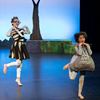















A Tale of Bravery of a Zebra, a Lioness and a Very, Very Small Bird
An optimistic and friendly Grévy’s zebra sees a reward poster for a rhino horn nailed to an acacia tree. She quickly hatches a plan and convinces a feared lioness and a hesitant, red-billed oxpecker to sneak out of the wildlife conservancy and save the endangered black rhinos. Soon these three endangered species and unlikely friends head into the perilous bush, which is filled with poachers hiding behind every tree. With the help of the lioness’ old friend, a puff adder and her snakelets, they save not only a herd of rhinos but a tigoni reed frog, a mama elephant, and her calf, too. Oh, and of course, a sleepwalking baby rhino! All the while fighting off the poachers to bring everyone back safe and sound to the conservancy. The play runs 60-65 mins (depending on the length of the 2 poacher battles).
Productions
Behind The Scenes
With Nikki Harmon
What inspired you to write this play?
The inspiration for the play came when I read about an odd verdict in a 2022 lawsuit – Almond Alliance v. California Fish & Game Commission – where the Judge ruled “bees are fish” that allowed bumble bees to be put on the California Endangered Species list.
So, I read through the legalese to understand what the Judge meant when he said:
“...the words in the statute are what prevail, and the statute here says 'invertebrates,' and it doesn't have a qualifying limitation of 'aquatic invertebrates and does not require them to be aquatic or terrestrial animals.”
Okay, I got it. Fish don’t have backbones, bees don’t have backbones, therefore bees are fish. And I thought that if we have to go through all that to save one species then they’re going to have to start saving each other! And that’s why I wrote the play.
What's your favorite part or line in the play? Why?
The battle over the frog is my favorite scene because it’s where the team works together to save one of their own.
My favorite line is: “I’m going into the bush with a lion. What could possibly go wrong?”
Where did the characters come from? Are they based on people you know?
The Grévy’s came from my having worked at Lewa Wildlife Conservancy on a project to relocate them back to Meru Nat’l Park after poachers had taken all the animals.
The puff adder comes from actually seeing one come slithering out of the ground!
The elephants and the lioness characters from watching a mother elephant step in between her calf and a lion to protect her at a watering hole, in Namibia.
The frog came from seeing dried up ponds and knowing they had nowhere to go.
The pelican, because species are being forced into each other’s habitat by human developement.
The Black rhinos, because they need saving.
And the sleepwalking baby rhino because who doesn’t love a sleepwalking baby rhino?
What did you try to achieve with this play?
I wrote the play to start a conversation with kids about saving our endangered species. To offer a way of understanding of not ‘what’ they are but ‘who’ they are, by showing the beauty, the intelligence, kindness and humor in species we’re losing every day. And to hope they’ll take their programs to school and tell their classmates about the zebra called a Grévy’s, and the loving mother elephant who stayed with her daughter until she was well, that’ll start a conversation about how there are fewer than 2,500 Grévy’s left in the wild, and that the World Wildlife Fund expects elephants will be extinct in 15 years if we don’t save them. So, let’s start a conversation now!
Do you have anything else you'd like to add?
We’re all of us, 6 degrees of separation, like the forest elephant in the savana, who 1) eats the fruit off the trees and poos the seeds that plants more trees; 2) that has bark used to make crafts to sell; 3) fruit that’s eaten; 4) the leaves for herbal cures; 5) their big foot prints make small watering holes for tiny animals, and finally 6) when they walk through puddles with fish the eggs cling to their rough hide and detach in the next pond creating more fish to be caught and eaten – we need each other because we are all SIX DEGREES OF SEPERATION.
